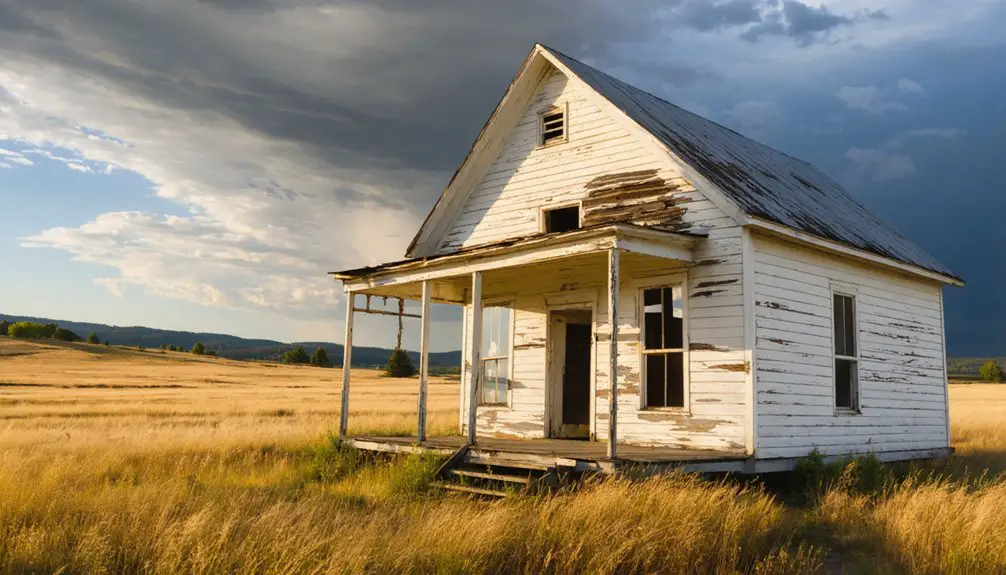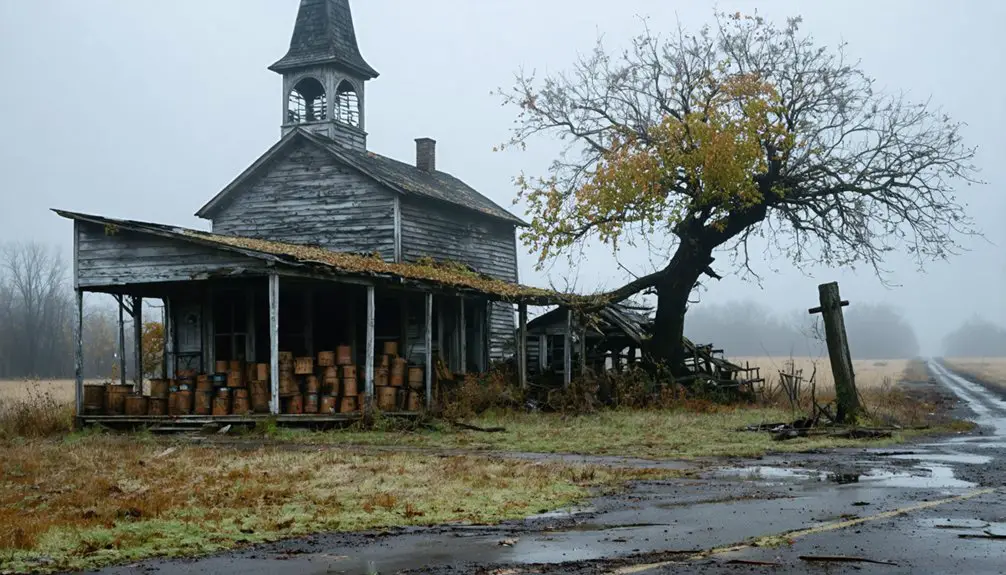You’ll find Richmond’s ghost town remnants in Wheeler County, Oregon, along Richmond Road southeast of Route 207. This frontier settlement, established in the 1880s and named during a pioneer dispute invoking Civil War memories, thrived until the early 1900s with its post office, Methodist church, and general store. The devastating Sheepshooters’ War (1895-1906) and declining mining operations led to its abandonment, though surviving 19th-century structures still tell tales of this once-bustling community.
Key Takeaways
- Richmond, Oregon became a ghost town following economic decline when mining profitability decreased and the sheep industry collapsed during the Sheepshooters’ War.
- Located in Wheeler County at 44°43′51″N and 119°59′32″W, Richmond was established in the 1880s and thrived until the early 20th century.
- The town’s post office operated from 1899 to 1952, marking the timeline of Richmond’s transformation from bustling community to abandonment.
- Historical structures including a Methodist church, general store, and IOOF hall still stand as remnants of Richmond’s former prominence.
- Richmond’s isolation and eventual bypassing by major transportation routes contributed significantly to its ghost town status.
Origins Behind the Confederate Name
While the origins of Richmond, Oregon’s name might seem puzzling given its Pacific Northwest location, the story stems from a heated dispute between pioneers R.N. Donnelly and William Walters over school location.
In a symbolic move reflecting Confederate symbolism of the era, Donnelly mockingly dubbed Walters “Jeff Davis,” drawing a parallel between Walters’ defiant attitude and the Confederate president Jefferson Davis. Richmond’s selection as the Confederate capital was based on its industrial capacity, which proved vital to the Southern cause.
The naming significance became clear when the town adopted “Richmond” as its moniker, deliberately invoking the Confederate capital of Richmond, Virginia. Like many place name references, the choice required careful disambiguation from other Richmond locations across the country.
Richmond’s naming deliberately echoed the Confederate capital, embedding Civil War symbolism into Oregon’s frontier landscape.
You’ll find this choice wasn’t random – it served as a pointed reference to Walters’ rebellious stance, embedding Civil War memory into Oregon’s pioneer culture despite being thousands of miles from the actual Confederate territory.
Early Settlement and Pioneer Life
After the arrival of the Gilliam, Donnelly, Keyes, and Walters families in the 1880s, Richmond began taking shape in Oregon’s remote Shoofly country. You’d find these early settlers establishing essential infrastructure, with pioneer education at the forefront of their priorities.
They built a school, though its placement sparked heated debates between R.N. Donnelly and William Walters, reflecting the strong-willed nature of frontier life.
The community’s spirit flourished through various gathering spots – a Methodist Church, an Odd Fellows hall, and a general store. You’ll appreciate how these settlers created bonds through community gatherings, particularly at the 1901 Wheeler County Pioneer Association meeting that drew 450 people. Like many biographical accounts of Oregon’s past, the stories of these gatherings provide valuable insights into early community life.
Daily life centered around farming, ranching, and maintaining important connections through the local post office, initially named Waldron before becoming Richmond in 1902. The town’s development was driven by the need to establish a local business center for residents who previously had to travel long distances to freight goods.
The Thriving Days of Richmond
During Richmond’s peak years at the turn of the 20th century, you’d find a bustling community hub serving Oregon’s remote Shoofly country. The town thrived on agriculture and local services, with prominent settlers like the Gilliam, Donnelly, Keyes, and Walters families driving its growth. Like many ghost towns in Texas, Richmond’s eventual decline reflected shifting economic patterns in the American West. Similar to how frontier history shaped Oregon’s development, Richmond emerged from the pioneering spirit of westward expansion.
Strong community engagement shaped local governance, evidenced by active debates over school placement and civic planning. The 1899 establishment of Richmond’s post office, later absorbing Waldron’s mail services, cemented the town’s regional importance.
- Original buildings still stand as proof of Richmond’s well-planned residential and commercial infrastructure
- Active local governance facilitated development of essential civic services
- Family-oriented population prioritized education and school construction
- Post office operations enhanced commerce and communication networks
- Community cooperation strengthened social bonds despite occasional disputes
Geographic Features and Location Details
The historic ghost town of Richmond sits precisely at 44°43′51″N and 119°59′32″W in Wheeler County, Oregon, nestled between the rugged breaks of the John Day River.
You’ll find this remote location along Richmond Road, southeast of its intersection with Oregon Route 207, positioned between Mitchell and Service Creek in what old-timers called Shoofly country.
The surrounding landscape showcases eastern Oregon’s dramatic river valleys and mountainous terrain, with Baldy Mountain dominating the horizon.
Like many ghost town sites, Richmond’s isolation and eventual abandonment resulted from being bypassed by major transportation routes.
The natural topography features rolling hills and steep river cuts that once attracted pioneer settlers despite the challenging environment.
While the rugged setting proved difficult for long-term development, you can still access this piece of frontier history via rural roads that wind through the untamed countryside characteristic of eastern Oregon’s backcountry.
The Sheepshooters’ War Impact
You’ll find Richmond’s darkest chapter in the Sheepshooters’ War of 1895-1906, when cattlemen killed over 25,000 sheep and destroyed numerous sheep camps across central and eastern Oregon.
The violence devastated Richmond’s sheep-based economy, as herders faced brutal attacks, property destruction, and the systematic elimination of their flocks. Grazing allotments were eventually established to separate cattle and sheep operations and reduce conflicts.
The conflict shattered community bonds, as neighbors turned against neighbors, ultimately contributing to Richmond’s decline when many sheepmen were forced to abandon their operations or convert to cattle ranching. The town’s population steadily decreased until the post office closed 1952, marking the final chapter of Richmond’s story.
Economic Devastation
Between 1895 and 1906, violent range wars devastated Oregon’s livestock economy as cattle ranchers systematically destroyed over 25,000 sheep across central and eastern regions.
You’ll find that this catastrophic period crippled sheep farming operations while destabilizing the entire agricultural sector. The destructive competition drove many small ranchers out of business as they couldn’t sustain the mounting security costs and livestock losses. The Panic of 1893 intensified the conflicts as crashing livestock prices forced desperate ranchers to compete fiercely for limited grazing lands.
- Sheepmen’s income streams collapsed due to massive herd destruction
- Range degradation intensified as desperate grazers fought over diminishing resources
- Saltpeter poisoning of grazing lands created long-lasting environmental damage
- Investment in local agriculture plummeted amid the lawless environment
- Federal regulation in 1906 forced costly changes to structured land management
Violent Range Wars
During Oregon’s darkest chapter of range violence, masked riders terrorized sheep camps across Richmond and surrounding territories, wielding brutal tactics to eliminate competition for grazing lands.
You’ll find evidence of their ruthlessness in the staggering numbers: over 25,000 sheep slaughtered between 1895 and 1906, with 2,300 killed in a single night in Lake County.
The cattlemen conflict reached its peak as paramilitary groups orchestrated surprise attacks, driving sheep over cliffs in “buffalo jumps” and burning camps.
While sheepmen sought peaceful solutions, their pleas for government intervention fell on deaf ears.
The violence fundamentally altered Richmond’s economic landscape, as the sheep slaughter forced herders to abandon their flocks, contributing to the town’s eventual decline and abandonment.
Community Trust Breakdown
The violent sheepshooters’ campaign shattered Richmond’s social fabric, as once-neighborly ranchers found themselves divided into hostile camps of sheepmen and cattlemen.
You’ll find this conflict destroyed community resilience when paramilitary groups slaughtered over 25,000 sheep between 1895-1906, devastating Richmond’s economic foundation.
County authorities’ failure to protect sheepmen’s rights and property eroded social cohesion, while Governor Chamberlain’s inaction further weakened trust in governance.
- Economic devastation forced sheepmen to abandon their traditional livelihood
- Law enforcement’s bias toward cattlemen created a dangerous power vacuum
- Isolation and violent attacks traumatized sheep-herding families
- Loss of neighborly cooperation threatened frontier survival systems
- Richmond’s identity as a sheep-herding community vanished, accelerating its decline to ghost town status
Community Buildings and Landmarks

Several essential community buildings defined Richmond’s social landscape during its heyday, anchored by a Methodist church, school, and Independent Order of Odd Fellows hall.
These structures fostered community gathering and social cohesion among the town’s agricultural settlers. You’ll find that the school, one of the first buildings constructed in the 1880s, sparked heated debates about its location – a controversy that ultimately influenced the town’s name.
The general store and post office served as crucial communication hubs from 1899 to 1952, while the IOOF hall hosted regular social events and meetings.
As Richmond’s beating heart, the general store and IOOF hall connected neighbors through daily commerce and community gatherings.
Today, you can still explore several original homes and structures that stand as silent witnesses to Richmond’s past, offering rare glimpses into 19th-century rural Oregon life.
Economic Rise and Decline
Mining activities formed Richmond’s economic bedrock in the late 19th century, drawing pioneering families like the Gilliams, Donnellys, Keyes, and Walters to stake their claims.
The mining impact transformed Richmond into a bustling frontier outpost, with essential services like the Waldron post office established in 1879. You’ll find that Richmond’s story mirrors many Western boomtowns, where rapid resource extraction drove temporary prosperity but limited economic sustainability.
- Located strategically between John Day River and Baldy Mountain for ideal mining operations
- Experienced classic boom-bust cycle common to extractive economies
- Relied heavily on single-industry focus, making it vulnerable to market changes
- Showed typical boomtown investment patterns with minimal fixed assets
- Declined as mining profitability decreased, leading to population exodus
Legacy and Remaining Structures

You’ll find Richmond’s enduring legacy in its handful of surviving 19th-century structures, including the weathered M-E Church, general store/post office, IOOF hall, and schoolhouse scattered across the original town site.
These buildings, now divided by modern asphalt roads, serve as rare physical reminders of Eastern Oregon’s pioneer era, with the Brothers store housing heritage displays and memorabilia from the town’s agricultural past.
The site’s historical value is enhanced by preserved pioneer family properties and the cemetery, making Richmond one of the few ghost towns in Eastern Oregon with substantial standing monuments to its frontier history.
Standing Historical Buildings
Today in Richmond, Oregon, you’ll find a collection of weathered but historically significant buildings that stand as evidence to the town’s prosperous past.
While historical preservation efforts remain informal, you can still explore the 1890s church with its Gothic Revival architectural features, the old schoolhouse that served early settlers, and remnants of the general store that once buzzed with activity.
Several original residential buildings showcase the modest yet durable pioneer craftsmanship that defined this sheep-herding community.
- The church building remains a reflection of the town’s spiritual foundation and community gatherings
- The schoolhouse represents Richmond’s commitment to education in Oregon’s frontier days
- Original homes tell stories of settler families like the Gilliams and Donnellys
- The general store ruins mark the former commercial heart of Richmond
- Wood-frame construction throughout reflects typical late 19th-century rural Oregon architecture
Cemetery and Memorial Sites
Among Richmond’s most poignant historical sites, the Wheeler County cemetery stands as a silent chronicle of the town’s bygone era, containing roughly 150 recorded graves of early settlers and residents.
You’ll find traditional headstones bearing inscriptions of prominent pioneer families like the Gilliams, Donnellys, Keyes, and Walters, offering glimpses into the community’s social fabric.
The cemetery’s memorial significance extends beyond its role as a burial ground. As one of the few remaining physical landmarks of Richmond’s existence, it serves as an essential resource for genealogists and historians studying Eastern Oregon’s settlement patterns.
While cemetery preservation efforts face ongoing challenges from weather exposure, the site continues to draw visitors seeking connections to Richmond’s frontier heritage and the stories of those who shaped this once-thriving community.
Pioneer Family Properties
Traces of Richmond’s pioneer heritage remain visible through scattered homesteads and surviving structures that once belonged to prominent settler families.
You’ll find these family legacies preserved in timber-framed houses and farmsteads, originally built in the 1850s along fertile valleys near Richmond.
Pioneer homesteads often spanned 640 acres, showcasing the ambitious scale of early settlement claims that shaped Oregon’s landscape.
- Original family houses stand as evidence to frontier construction techniques, evolving from log cabins to more sophisticated timber frames.
- Agricultural infrastructure reveals how settlers transformed wilderness into productive farmland.
- Preserved homesteads offer glimpses into daily pioneer life and early farming practices.
- Historic structures maintain essential connections to founding families’ contributions.
- Community buildings, including schools and churches, reflect settlers’ commitment to establishing permanent roots.
Frequently Asked Questions
Are There Any Documented Paranormal Activities in Richmond’s Abandoned Buildings?
You won’t find any verified ghost sightings or officially documented haunted locations in the buildings. Unlike other Oregon ghost towns, there’s no credible evidence of paranormal activity in these abandoned structures.
What Happened to the Original Residents After Richmond Became a Ghost Town?
After Richmond’s post office closed in 1952, former inhabitants moved to surrounding towns like Fossil and Condon. You’ll find many of their relocation stories centered around Wheeler County’s shift from sheep to cattle ranching.
Can Visitors Legally Explore and Photograph the Remaining Structures Today?
You’ll need explicit landowner permission before exploring or photographing, as the structures sit on private land. While you can view from public roads, exploration regulations require prior consent for closer access.
Were There Any Notable Crimes or Outlaws Associated With Richmond?
While you might expect outlaw legends, Richmond’s crime history centered on sheep conflicts and settler feuds, not bandits. The town’s tensions were more about grazing rights than gunslinging desperados.
How Many People Lived in Richmond During Its Peak Population?
You’ll find that Richmond’s population growth peaked at roughly 700 residents during its most prosperous period, marking its historical significance as one of Oregon’s larger mining communities in the region.
References
- https://www.bendsource.com/news/ghost-towns-of-central-oregon-14722697
- https://traveloregon.com/things-to-do/culture-history/ghost-towns/richmond/
- https://crookcountyhistorycenter.org/2022/07/richmond-thriving-community-that-became-a-ghost-town/
- https://en.wikipedia.org/wiki/Richmond
- https://en.wikipedia.org/wiki/List_of_ghost_towns_in_Oregon
- https://scholarscompass.vcu.edu/cgi/viewcontent.cgi?article=4712&context=etd
- https://www.essentialcivilwarcurriculum.com/richmond-capital-of-the-confederacy.html
- https://www.battlefields.org/learn/articles/capital-cities-confederacy
- https://artsandculture.google.com/story/disciples-of-vulcan-examining-the-oregon-hill-community-the-valentine-richmond-history-center/RQXRggijghsA8A?hl=en
- https://en.wikisource.org/wiki/The_Centennial_History_of_Oregon



